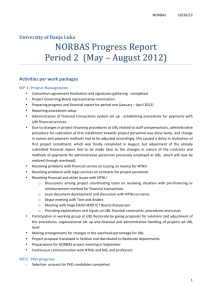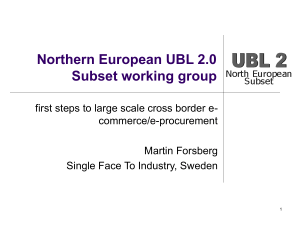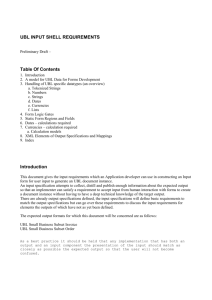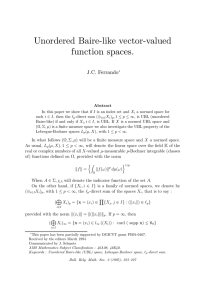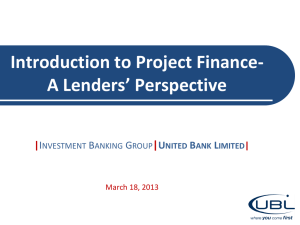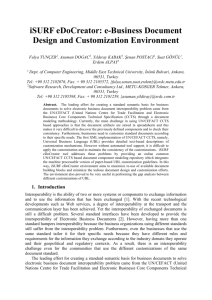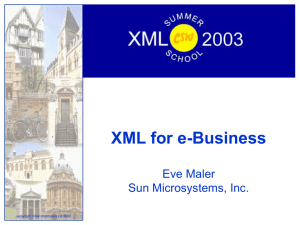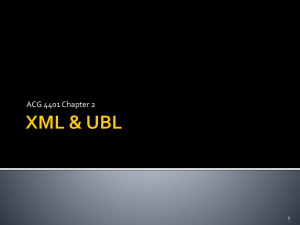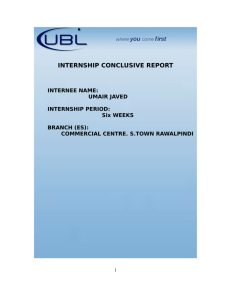Dear Mr - OASIS Mailing List Directory
advertisement
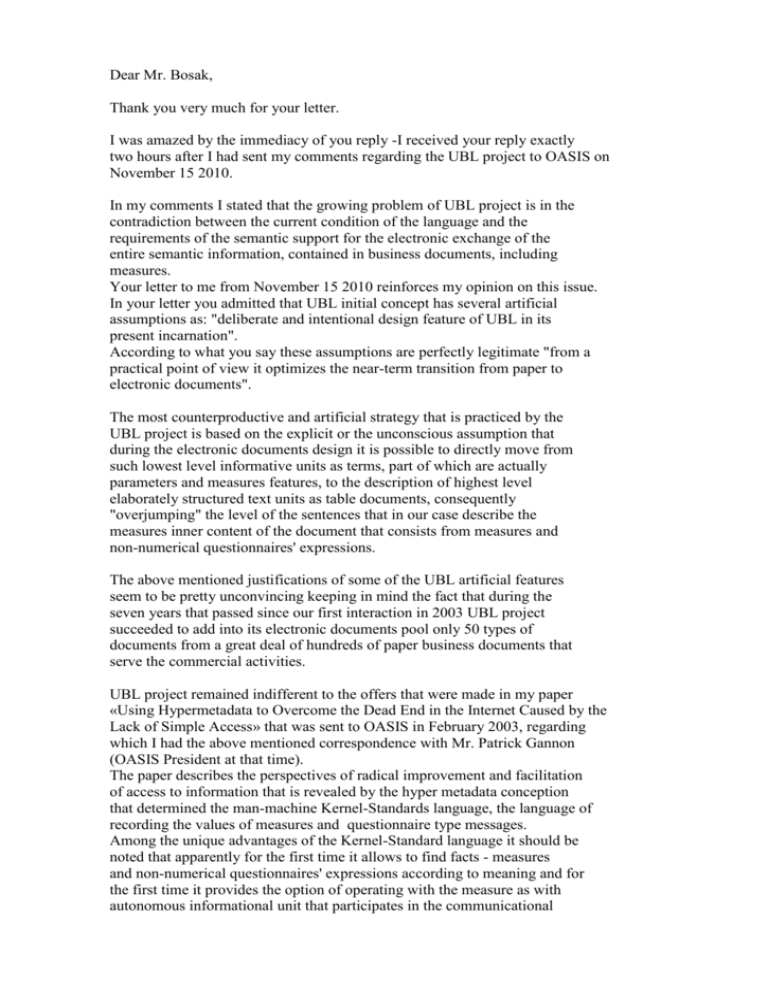
Dear Mr. Bosak, Thank you very much for your letter. I was amazed by the immediacy of you reply -I received your reply exactly two hours after I had sent my comments regarding the UBL project to OASIS on November 15 2010. In my comments I stated that the growing problem of UBL project is in the contradiction between the current condition of the language and the requirements of the semantic support for the electronic exchange of the entire semantic information, contained in business documents, including measures. Your letter to me from November 15 2010 reinforces my opinion on this issue. In your letter you admitted that UBL initial concept has several artificial assumptions as: "deliberate and intentional design feature of UBL in its present incarnation". According to what you say these assumptions are perfectly legitimate "from a practical point of view it optimizes the near-term transition from paper to electronic documents". The most counterproductive and artificial strategy that is practiced by the UBL project is based on the explicit or the unconscious assumption that during the electronic documents design it is possible to directly move from such lowest level informative units as terms, part of which are actually parameters and measures features, to the description of highest level elaborately structured text units as table documents, consequently "overjumping" the level of the sentences that in our case describe the measures inner content of the document that consists from measures and non-numerical questionnaires' expressions. The above mentioned justifications of some of the UBL artificial features seem to be pretty unconvincing keeping in mind the fact that during the seven years that passed since our first interaction in 2003 UBL project succeeded to add into its electronic documents pool only 50 types of documents from a great deal of hundreds of paper business documents that serve the commercial activities. UBL project remained indifferent to the offers that were made in my paper «Using Hypermetadata to Overcome the Dead End in the Internet Caused by the Lack of Simple Access» that was sent to OASIS in February 2003, regarding which I had the above mentioned correspondence with Mr. Patrick Gannon (OASIS President at that time). The paper describes the perspectives of radical improvement and facilitation of access to information that is revealed by the hyper metadata conception that determined the man-machine Kernel-Standards language, the language of recording the values of measures and questionnaire type messages. Among the unique advantages of the Kernel-Standard language it should be noted that apparently for the first time it allows to find facts - measures and non-numerical questionnaires' expressions according to meaning and for the first time it provides the option of operating with the measure as with autonomous informational unit that participates in the communicational process independently from the document. This language is the main tool of the simple access for an unskilled user, without, by the way, the need to use key words. On the basis of the language a method of machine translation of paper documents into electronic documents was invented - the method of Structure Content Description (SCD) of documentation forms. SCD method is employed in machine programs that automatically form complicated table documents with hierarchical order in columns and rows, moreover, of documents of any type, in any desirable format and containing any composition of measures and questionnaire expressions. The unique options of Kernel Standards Language, specifically in the passage from paper documents to electronic documents, are confirmed by the many years of successful practical usage of the Kernel standards technology that implements the Kernel-Standards concept of hyper metadata in state economic organizations and private companies. The SCD method, that seemingly was created by the Providence itself for the UBL project and that was ignored by it up till now, was intentionally and as much as possible in detail described by me back in the year 2003 in my above mentioned paper, using the example of Purchase Order document. This reminds me that in the comments of November 2010 that were addressed to ubl-comment@lists.oasis-open.org, I substantially showed how to develop the SCD of documents, which allows their automatic formation in a given electronic form, now on the example of two Purchase Order documents options - the old one and the new one, formed as electronic table. From your letter it can be concluded that you are still holding the same opinion as you have stated in your conclusion sent to Patrick Gannon on February 4 2003 that reads as follows: «I do not see anything in Professor Kruglicov's paper that would materially increase access to business data among the users for whom UBL is intended». As for me it seems to be to some extent contradictory. On the one hand you do not claim that the means of access suggested by Professor Kruglikov are doubtful, but on the other hand for an expert of such degree as you are, it seems to be impossible not to notice that the suggested tools revolutionalize the data search, since they allow, and not only for the advanced potential users of UBL, but even for the unskilled users to more or less easily find facts instead of lists of links to documents that are issued by traditional search systems for requests with key words. In my comments, on which you responded, I noted that UBL lacks standard automatic means for documents design, optimized for conditions of specific fields and enterprises, which leads to a loss of certain advantages of local optimization that takes into consideration the particularity of business activity spheres. I believe that such situation is directly connected with disregard to the measures semantics. You are convinced that UBL users will prefer the access methods that require understanding of UBL schemes and manual programming each time when an electronic document is needed, when they can have methods that do not require these things, using tools of automatic ad hoc requests formation for electronic documents in a familiar format almost without any manual work. In these conditions your conviction seems to be unrealistic. I would really like to hope that there will be time when OASIS UBL TC will abandon its strategy of "over-jumping" the measures semantics in the passage from paper documents to electronic documents, and will make the combination of Kernel-Standards Language with the important experience that was acquired by the URL project, which will allow to create UBSTSL - Universal Business Science Technique Society Language. Another thing I wanted to clarify is that my above mentioned paper from 2003 was issued by Google by the URL indicated in my comments, regarding which you wrote that it "does not resolve to any existing document". Best Regards, Prof. Boris Kruglikov Wednesday, November 24, 2010 ----- Original Message ----From: "Jon Bosak" <bosak@pinax.com> To: "Boris Kruglikov" <kerolga@netvision.net.il> Cc: <ubl-comment@lists.oasis-open.org> Sent: Monday, November 15, 2010 5:23 PM Subject: Re: [ubl-comment] Comment UBL : Use semantic of measures in Support of electronik exchange of business documents > Dear Mr. Kruglikov, > > Thank you very much for your comment. > > Regarding the URL you provide for your earlier communication with > Patrick Gannon (who is no longer employed by OASIS): > > http://lists.oasis-open.org/archives/ubl-csc/200302/rtf00000.rtf > > This URL does not resolve to any existing document. I note that > the directory ubl-csc/200302 does not exist and that the ubl-csc > mail list would have been an inappropriate location for this > communication in any case. After some searching, I found a copy > forwarded by Sue Probert to the UBL LCSC list at > > http://lists.oasis-open.org/archives/ubl-lcsc/200302/msg00012.html > > I also find a response to this earlier draft sent from me to > Patrick Gannon 4 February 2003 that reads as follows: > > | Patrick, >| > | I do not see anything in Professor Kruglicov's paper that would > | materially increase access to business data among the users for > | whom UBL is intended. UBL is intended for use by people who > | already understand and are familiar with the common documents of > | trade such as purchase orders and invoices and who use only one > | set of agreed-upon UBL schemas in their regular relationships with > | trading partners. I do not believe that such users would find > | benefit in access methods beyond what could very easily be > | programmed by anyone with knowledge of the schema. It is true > | that many users will require UBL documents to be displayed in a > | familiar form, but we are already working on a package of such > | stylesheets for this purpose that should be appearing within the > | next week or two. >| > | I thank Professor Kruglicov for his interest in our work and > | invite him to contribute comments on the schemas as specified in > | the notice accompanying the release of Library Content 0p70. >| > | Best regards, >| > | Jon > > I apologize for Patrick if he failed to forward that earlier > message. > > Regarding to references to "measures" in the paper attached to > your message of 15 November 2010, you should be aware that UBL is > designed to separate the structure and labeling of business > information items (the correctness of which is enforced through > XML validation) from constraints on their values (the correctness > of which is typically enforced in downstream processing). While > in a larger sense this division is artificial, from a practical > point of view it optimizes the near-term transition from paper to > electronic documents. In any case, it is a deliberate and > intentional design feature of UBL in its present incarnation. > > If you wish to pursue your approach in a standards setting, I > suggest that you join OASIS as an individual member and seek the > formation of a new Technical Committee to further develop it. You > may also find the work of the OASIS Quantities and Units of > Measure Ontology Standard (QUOMOS) Technical Committee of > interest: > > http://www.oasis-open.org/committees/tc_home.php?wg_abbrev=quomos > > Best regards, > > Jon Bosak > Chair, OASIS UBL TC > >
